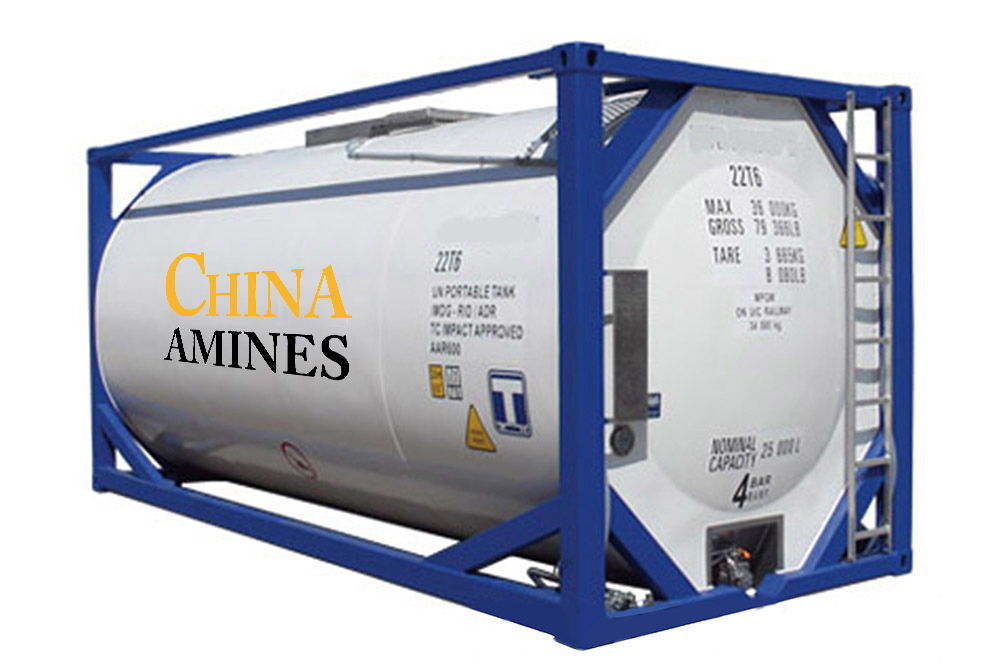Your Questions and Comments
Your sales and customer service desk partners within China Amines Co will continue to serve you. You can also contact us via our headquarter office-
Email:info@chinaamines.com
China Amines Co
Product Profile
1. Chemical Structure and Properties
Molecular Formula:
C₃H₉N
Structural Formula:
(CH₃)₃N
Tertiary amine with a trigonal pyramidal geometry, featuring three methyl groups attached to a central nitrogen atom.
Physical Properties:
- State: Colorless gas at standard conditions; commonly stored as a 40% aqueous solution (boiling point of solution: ~85°C).
- Density: 0.63 g/cm³ (gas), 0.67 g/cm³ (liquid).
- Odor Profile: Pungent, ammonia-like odor detectable at 0.002 ppm (olfactory threshold).
Chemical Behavior:
- Basicity: Strong base (pKa = 9.8 in water), reacts exothermically with acids to form salts (e.g., trimethylamine hydrochloride).
- Reactivity: Combustible (flash point: -7°C) and forms explosive peroxides upon prolonged exposure to air.
2. Industrial Applications
Chemical Manufacturing:
- Choline Derivatives: Primary feedstock for choline chloride (animal feed additive, global production >600,000 t/year).
- Pharmaceuticals: Building block for antihistamines and neurological drugs.
Gas Processing:
- Acid Gas Removal: Utilized in amine scrubbing systems (e.g., Shell’s ADIP process).
Surfactants:
- Production of trimethylamine oxide (TMAO) for detergents and personal care products.
Agriculture:
- Intermediate in glyphosate herbicide synthesis.
3. Safety and Toxicology
Hazard Profile:
- Inhalation (≥50 ppm): Severe respiratory irritation, pulmonary edema.
- Skin Contact (liquid): Frostbite risk.
Acute Exposure:
- Chronic Effects: Potential liver/kidney damage.
Flammability:
Class 1 flammable gas (NFPA 704 rating: Health 3, Flammability 4).
Protection Protocols:
- Engineering Controls: Explosion-proof ventilation, gas detectors.
- PPE: SCBA, neoprene gloves.
Regulatory Limits:
OSHA PEL: 10 ppm (8-hour TWA); IDLH: 500 ppm.
4. Environmental and Regulatory Compliance
Ecotoxicology:
- Aquatic Toxicity: LC50 (fish): 80 mg/L; EC50 (algae): 25 mg/L.
- Biodegradation: Rapid in aerobic conditions (half-life <24 hours).
- Atmospheric Impact: Contributes to secondary aerosol formation via NOx reaction.
Global Regulations:
- EU: CLP Regulation (H221: Flammable gas; H331: Toxic if inhaled).
- US EPA: Listed as a TRI chemical.
- China: GB 13690-2009, Category 2.1 hazardous chemical.
Transportation:
UN 1083 (anhydrous), UN 1296 (aqueous solution); Class 2.1 hazard label required.
5. Case Studies and Comparative Analysis
Case 1: Choline Chloride Production
Process: TMA reacts with ethylene oxide to form choline, then neutralized with HCl.
Efficiency: 95% yield at 80°C with zeolite catalysts (BASF method).
Case 2: Natural Gas Sweetening
Application: ADIP-X process uses TMA-based solvents to reduce H₂S to <4 ppm.
Operational Data: 20% energy savings vs. MEA systems.
Alternative Comparison:
- Cost: TMA is 30% cheaper but requires stricter safety protocols.
- Performance: DMA has higher selectivity for CO₂ but lower reaction kinetics.


